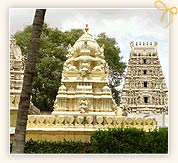
The Hindu religious temple is a house of worship for
the followers of Hinduism. They are usually dedicated to any one prime
deity or multiple of them. They inherited rich & ancient rituals &
customs which have been kept intact till date. Since ages, the
architectural part has been given prime importance keeping in mind the
religious and spiritual activities to be followed at these sacred
places. Today, they not only serve as pilgrim centers but also has hot
tourist destinations simply because of their intricate architectural
designs & patterns. The legends related to them make them all the more
happening in every way.
Most of these were constructed as per the agama shastras. Vasstu
Shastra is given due importance which is the science of aesthetic &
auspicious designs. The common sight of most of the Hindu religious
temples is the presence of the elaborate idols of the deity. Since the
Vedic age, the milieu of the temple was equally kept in high esteem.
Roch cut architecture, cave style temples carved out rocks are
examples. Elaborate sculptures & paintings would adorn the walls of
these temples. The spiritual temples are found in abundance throughout
the country. The major centers come under these two prominent
categories :
Char Dham
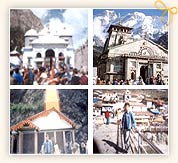
The Char Dham is considered a vital Hindu
pilgrimage circuit in the Indian Himalayas. The picture perfect
location in the Garhwal section of the state of Uttarakhand,
consists of four sites - Yamunotri, Gangotri, Kedarnath and
Badrinath. All the site in the circuit has the backing of an
autonomous history. They are seen as hot destinations because of
their beautiful locales as well as pilgrim centers. The Char Dham
has always been seen as a source to come in contact with the divine
power. The mystical journey has been mentioned as 'Kedarkhand' in
ancient Hindu scriptures.
As per the Hindu scriptures, all these holy centers are very sacred
of all pilgrimages. One gets rid of all his sins when making a trip
to any of these sacred places. It is believed that he gets free from
worldly clutches, & thus, is blessed with Moksha. The beautiful
placing of the spiritual Char Dham is seen as a meeting point for
heaven and earth. The journey towards Chardham must be started from
left to right - i.e. beginning with Yamunotri, then moving on to
Gangotri, Kedarnath before finally ending the journey at Badrinath.
This particular adoption of the route actually follows the Hindu
tradition of parikrama or clockwise circulation.
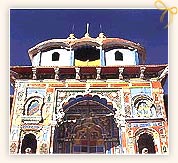
Badrinath is a Hindu holy town in Uttaranchal, India
and considered to be the most important of the four sites in India's
Chardham pilgrimage. It is an important destination on the sacred
itinerary of every devout Hindu. It has been emphasized in the ancient
scriptures that there are many sacred spots of pilgrimage in the
Earth, Heaven and the Nether world, but there has been none equal to
Badri nor there shall be. The significance of this place is that it is
considered to be the seat of the God Vishnu in his aspect of
Badrinarayana. The prime sites in this area are Badrinath Temple, Tapt
Kund, Brahma Kapal, Charanpaduka, Sheshnetra, Neelkantha. Another
important religious attraction at Badrinath is the Badrinath Temple
which is considered as the abode of Lord Vishnu and is situated at
3,124 meters above sea level in the Himalayas. The temple has three
parts - Garbha Grih (The Sanctum Sanctorum), Darshan Mandap (for pujas)
and Sabha Mandap (for devotees to assemble). At the backdrop is the
Neelkanth mountain peak situated between twin peaks named Nar and
Narayan. The Badrinath temple was built by the Gharwal kings.
The temple is more than two centuries old. It is believed that Lord
Vishnu came to the area, called 'Badri Van', or the berry garden, to
meditate after Narad rebuked the Lord for being immersed in worldly
pleasures. The main idol in the temple is that of Lord Vishnu in the
form of a black stone. Lord Vishnu is in a meditative stance with both
hands on his lap. The sacred river Alaknanda flows by the temple. The
holy river Alaknanda is fed by the Badrinath glaciers and the Holy
Ganges. The temple of Badrinathji is five meters high, it is built in
the form of a cone with a small coupla of a gilt bull and spire. The
temple opens every year in the month of April-May and closes for
winters in the third week of November. At one time the spot was
covered with wild berries ("badris") and was famous as the "Badri Van"
(the garden of wild berries). Facing the temple at the bank of
Alaknanda River is "Tapt Kund"a hot water spring, a bath in this
spring is a very refreshing experience for the travelers. It is
believed to be a reliever from many diseases.
Places of Interest
The nearby places of interest are the Panch Badri namely :
Yog Dhyan Badri
The temple of Yog dhyan Badri, one of the five Badris. It is located
at Pandukeshwar. The location is just 24 km short from Badrinath on
the Rishikesh Badrinath highway. The image, worshipped here is that of
the Lord in a meditative posture. It is believed that the Pandavas
settled here after handing over Hastinapur to king Parikshit.
Bhavishya Badri
Bhavishya Badri is located at Subain near Tapovan, about 17kms. east
of Joshimath on Joshimath - Lata Malari route. Pilgrims have to trek
beyond Tapovan, up the Dhauliganga river. The temple of Bhavishya
Badri is at an elevation 3641mts., and is surrounded by dense forests.
It is believed that one day the route to Badrinath temple will become
inaccessible and then Lord Badrinath will be worshipped here. Hence
this place is rightly called Bhavishya Badri meaning the future Badri.
Adi Badri
Adi Badri is believed to be the ancient aboard of Bhagwan Badrinath.
The Idol worshiped here is a black stone depicting Lord Vishnu. This
place is approachable from Karnprayag by a motorable road on the way
to Ranikhet. There are 16 small ancient temples, 7 among them belong
to the late Gupta period. The credit for building these temples is
given to Shankaracharya. The main temple of Lord Narayan is situated
on a raised platform in the pyramidal form where the idol is
enshrined. The idol of Lord Vishnu is a meter high. Adi Badri is
considered as the emerging source of river Saraswati.
Vriddha Badri
The idol placed here is known as vriddha old or the first Badri and
the temple remains open throughout the year. It is situated at an
altitude of 1380mts. and at a distance of 7kms. from Joshimath. The
idol of Badrinath was enshrined and worshiped here before the advent
of Adi Guru Shankaracharya.
Things to remember
- The Badrinath temple remains closed during winter and is open
from April to November
- One may carry light woolen between June - September
- One should carry heavy woolen between October - November
- Languages spoken - Hindi, English and Garwali
The other nearby places to visit are :
- Panchshilas
- Panchdharas
- Mata murty temple
- Mana Village
- Vasudhara
- Bhim Pul
- Vyas GutaYogadhyan Badri
- Alkapuri
- Satopnath Swargarohan Parbat
Gangotri Temple
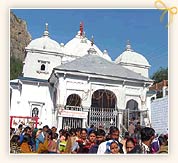
Gangotri, is known as the source of river Ganges
and is believed that Goddess Ganga resides here. Gangotri is one of
the four sites of Char Dhaam. The physical source of the river is at
Gaumukh, this place is 18 km ahead. Pilgrims do trek this path to
offer prayer to the Goddess at this holy spot. At the source the
river is called Bhagirathi and from Devprayag it is called Ganga
here it meets river Alaknanda. The origin of the holy river Ganges
is at Gaumukh. The place is approachable after 18 km trek along the
Gangotri glacier. According to popular legends, Goddess Ganga took
the form of a river in order to wash off the sins committed by the
King Bhagirath's predecessors. There is a submerged Shivling in the
river. It is believed that Lord Shiva sat here and tamed the gushing
flow of river Ganges in his matted locks.
The temple dedicated to Lord Ganges is situated at the right bank of
the river Bhagirathi. The temple has a height of 3042 mts. The
temple was constructed by a Gorkha commander called Amar Singh in
the 18th century. The peak season when lakhs of pilgrims visit
Gangotri is between May to October. By November Gangotri is covered
by snow and hence becomes inaccessible. It is believed that by
winter Goddess retreats to Mukhba her winter abode, this place is 12
km downstream. The physical surrounding of this holy spot is such
that it proves to be an ideal trekking spot for sport enthusiasts.
The other nearby places of interest are-
- Surya Kund : A place where pilgrims offer their prayers
to the Hindu Sun God
- Vishnu Kund : A holy place of worship where pilgrims
offer their prayers to Lord Vishnu-the preserver
- Brahma Kund : A holy spot where the pilgrims offer
their auspicious prayers to Lord Brahma -the creator
- The submerged Shivling : This is a site a pilgrim must
visit. This site has immense visual value. It speaks a silent
language of God's power. It is believed that Lord Shiva sat here
to tame the gushing force of the river Ganges in his locking
mates.
- Nandavan Tapovan : This site is ideal for excursion.
Nandan Tapovan is situated at distance of 6 Km from Gangotri. A
trek along the Gangotri glacier leads to this beautiful place
which is really a visual treat. One can see the beautiful Shivalik
peak from here.
- Uttarkashi : Uttarkashi is another place to visit. It
is situated at a distance of 99km from Gangotri. This place is
accessible after a long trek along the Gangotri glacier. situated
at an elevation of 1,150 mts. above sea level on the bank of river
Bhagirathi. There are some important temples to visit in
Uttarkashi like-
- Vishwanath temple
- Ekadash Rudra temple
- Gyaneshwar temple
- Kuteti Devi Temple
Kedar Tal : It is a beautiful lake, 4425 mts. above sea
level. This lake is placed at the exotic backdrop of the
Thalaiyasagar peak. This place is accessible after rough mountain
trekking. Kedartal serves as a base camp for trekking to the other
surrounding mountain peaks.
Gaumukh : It is the mouth of the sacred Gangs river. Pilgrims
reach the spot after a long trek from gangotri. The pilgrim offer
their prayers to the Goddess and take a holy dip in the chilling
water of the Ganges.
Bhairon Ghati : This spot is surrounded by thick forest and
is situated towards Uttarkashi. This place is famous for the famous
temple of Bhairo Nath.
Harsil : This location is situated in the mountain district
of Uttarkashi. Sat Tal is a nearby tourist destination. Harsil is
famous for it's scenic beauty and for delicious apples.
Gangani : This place is noted for it's splendid landscape,
thermal springs and peaceful surroundings. Bhatwari a small upcoming
town 12 km away from Gangani is a must visit.
Maneri : Maneri is a spot that is worth visiting for its
beautiful surroundings, the nearby lake and also the dam across the
river Bhagirathi.
Dayara Bugyal : Dayara Bugyal is famous for its magnificent
ski slopes spread over an area of 28 sq.km. Dayara is approachable
from Bhatwari after a 6km trek. Bhatwari is 27 km from Uttarkashi.
The famous Shashang temple is an attraction while trekking. This
spot is famous for it's splendid scenic beauty. The spot is situated
at a height of 3048 meters.
Dodi Tal : This sparkling lake is situated at an elevation of
2286 mts. The lake is surrounded by dense forests. The famous
himalayan fresh water fish are found here in abundance. This site is
a must visit for auatic life lovers.
Nachiketa Tal : This spot is famous for its beautiful
scenery. A small temple along the lake is also very famous. This
spot is approachable after a pleasant trek through a rich green
forest.
Tehri : This spot is famous for a giant hydel project. This
beautiful spot lies in the confluence of the Bhagirathi and Bhilanga
river. This spot is generally visited by tourists who like to travel
and venture more into this beautiful pilgrim spot after paying
homage at Gangaotri.
Narendranagar : From this spot one can view the beautiful
scenic beauty of Ganga valley of Rishikesh and the plains of
Haridwar. Narendranagar is the new capital of erstwhile Tehri.
Things to remember
- The main season to visit Gangotri is April to November.
- One may carry light woolen in summer.
- One should carry very heavy woolen in winter.
- The colloquial language is Hindi, Garhwali & English.
- The nearest airport is Jolly Grant, 226 km from Dehradun.
- The nearest railway station is Rishikesh.
- The road route is well connected Well connected to Rishikesh,
Haridwar, Dehradun and Delhi.
- A number of ashrams, dharamshalas, guest houses, private guest
houses serve as a convenient stay.
- The local eating joints dhabas are an ideal place to eat. They
serve tasty vegetarian food. Non vegetarian food and liqour is
prohibited.
Kedarnath

Kedarnath is a Hindu holy town located in the the
Indian state of Uttaranchal. The place is located at an altitude of
3,584 m and at the origin of the river Mandakini, the temple of
Kedarnath is the most venerated place for Hindu pilgrims. Amidst the
dramatic mountain scapes of the majestic Kedarnath range stands one
of the twelve 'Jyotirlingas' of Kedar or Lord Shiva. Kedarnath hosts
one of the holiest Hindu temples and is a popular destination for
Hindu pilgrims from all over the world. The place is accessible
after a steep 13 km trek over a paved path from Gaurikund. Rishikesh,
Haridwar, Dehradun are well connected to Gaurikund by road. There
are different places on the route like- Rambara, Janglechatti and
Garurchatti, where one can spend some time while trekking or can
even spend a night as a halting station. There is a high and
beautiful cascading waterfall just one kilometer before Rambara. The
main attraction at Kedarnath is the Kedarnath Jyotirlinga Temple,
which is one of the Panch Kendras located in the Himalayas, at the
source of the Mandakani river. It is about 120000 feet above the sea
level. One can get a glimpse of the God when traveling by foot. The
picture perfect setting with breathtaking scenic beauty transforms
it in a heaven. Perpetually covered with snow, the place is best
accessible from May to October except the Monsoon.
The credit for the construction of this heavenly temple is given to
the Pandavas. The entrance starts with the statue of Nandi, the
divine bull of Shiva. Fine & detailed carvings exhibiting images can
be seen on the walls inside. The shiva lingam is in the form of a
pyramid. The Kedar dome peak is located exactly behind the temple.
It can be viewed from great distance as well. The temple is located
on the Rudra Himalaya range, also known as the Pancha Parvata. It is
believed that four of the Pandavas died on one of the peaks,
Swargarohini.
The holy statue of Shiva is carried from Garhwal (Kedarkhand) to
Ukhnimath in November which is then restablished at Kedarnath in the
first week of May. The doors of the temple are now thrown open to
pilgrims.
Mythology states that the deity of Kedarnath temple is identified
with the rump of a bull. Shiva had camouflaged himself while eluding
the Pandavas, who had come to repent for killing their kith and kin,
during the battle of Kurukshetra. Shiva dived into the ground, thus,
leaving a hump on the surface. This very conical projection is
worshipped till now.
The temple is open only during the months of May to October, due to
heavy snowfall and extreme cold weather during winter. The origin of
this revered temple is mentioned in the great epic-Mahabharata.
According to the saying it is believed that the Pandavas came to
Lord Shiva to seek blessings to atone their sins after the battle of
Mahabharata. Lord Shiva evaded them continuously and took refuge in
Kedarnath in the form of a Bull. On being chased, Lord Shiva left
his hump behind. This conical protusion is worshiped in the temple.
During the winters, the shrine is submerged in snow and hence is
closed. The ideal time to visit is between May to October. The
remaining portions of Lord Shiva are worshiped at four other places
like-
- The arms {baahu} - at Tungnath
- The mouth {mukh} - at Rudranath
- The hair {jata} - at Kapleshwar
Things to remember
- The best season to visit is May to October except monsoon
- One may carry light woolens in summer and must carry heavy
woolens in winter
- The colloquial Language in use are Hindi, Garhwali and English
- The nearest airport is Jolly Grant, Dehradun (251 kms.)
- The nearest railway stations are Rishikesh (234 kms.) Kotdwar
(260 kms.)
- The walking route starts from Gaurikund which is connected by
road to Rishikesh, Kotdwar, Dehradun, Haridwar and other important
hill stations of Garhwal and Kumaon region
- There are halting stations like Dharamshalas, Ashrams,
Cottages and Tourist Rest House for comfortable stay
There are some important fairs that are organized at Kedarnath
anually like :
- Nagnath (Feb.)
- Sardotsava, Joshimath (Feb.)
- Sardotsava Chamoli, Gopeshwar (Feb. - Mar.)
- Shivaratri, Gopeshwar (Feb. - Mar.)
- Nanda Devi, Nauti (Mar.)
- Maithan, Maithan (Mar.)
- Bishwat Sankranti, Karnaprayag
- Nandprayag (April)
- Bikhot, Agastyamuni (April)
- Nautha, Adi Badri (May)
- Kaviltha, Kaviltha (Jun.)
- Naumi, Jasoli Haryali (Aug.)
- Bhaikhal, Mela, Bhaikhaltal (Aug.)
Yamunotri Temple
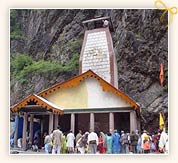
The shrine of Yamunotri is situated in the opposite
direction of Gangotri. Yamunotri is the source of river yamuna which
originates from the Champasar Glacier. This spot is not generally
visited by pilgrims as it is not easy to approach the place. The
shrine is placed at an elevation of 3235 meters. Dharasu is the
strategic point from where the road bifurcates to Yamunotri and
Gangotri, this place is between Rishikesh- Uttarkashi. The holy
shrine of Yamunotri is one of the four Dhams of Uttarakhand. At an
altitude of 4421 meters is situated the source of Yamuna, this is 1
km ahead of the shrine. Reaching the source is very difficult hence
the pilgrims offer their prayers in the shrine itself. The pilgrims
take a refreshing bath in the hot water springs situated nearby the
temple.
This bath in the water spring is very relieving after a long and
tedious trek. The most popular hot water spring is the Surya Kund.
This hot water spring is used to prepare the prashad of the temple
by tying rice and potato in cloth and dipping it in the hot water
spring. In Surya Kund the temperature of the water is 190°F. The
legends say that the temple was built by Maharani Gularia of Jaipur
in the 19th century. The shrine is dedicated to Lord Yamuna and is
represented in the form of a silver idol. It is believed that a
highly worshipped hermit, Asit Muni resided here. Goddess Yamuna is
the daughter of Lord Surya and Sangya, the Goddess of consciousness.
Goddess Yamuna is the sister of Lord Yama, the God of death. It is
hence believed that anyone taking a bath in the river Yamuna escapes
a painful death. Before entering the temple the pilgrims worship a
rock pillar called Divya Shilla. The main season to visit yamunotri
is during summers.
The other places to visit apart from the shrine are:
- Surya Kund : This is a hot water spring. A very
interesting fact about this spring is that the main prashad of the
temple is prepared in the Surya Kund. It is very refreshing for
the pilgrims to take a bath in Surya Kund.
- Divya Shilla : Divya Shilla is a rock pillar situated
before the temple. The devotees offer their prayers here before
visiting the main shrine of Goddess Yamuna.
- Sayanachatti : This is a beautiful scenic spot situated
on the banks of river Yamuna. This place is 29 km from Barkot.
- Jankichatti : This place is known for it's thermal
springs. The pilgrims take a refreshing bath here after their long
treks.
- Hanumanchatti : This spot is the confluence of Hanuman
Ganga and river Yamuna. The trek to Dodi Tal starts from here.
Things to remember
- One should carry light woolens during summer.
- One should carry heavy woolens in winters.
- The colloquial language is Hindi, Garhwali, English.
- The nearest airport is Jolly Grant which is 18 kms from
Rishikesh.
- The nearest railway station is Rishikesh.
- Dharamshalas are the main source of accommodation.
- The local dhabas are the main eating out joints.
- Alcohol and non vegetarian food is prohibited in Yamunotri.
Jyotirlinga Temple
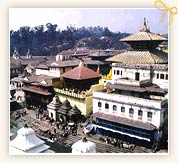
The 12 jyotirlinga shrines, popularly known as the
Dwadasa Jyotirlinga shrines are considered to be very holy by the
Hindus. The Jyotirlingas have held an important position in the
Indian belief system. The Jyotirlinga temples have a rich tradition
and each temple has a legend attached to it. They are situated in
different parts of India. The northernmost Jyotirlinga is located in
the snow clad Himalayas at Kedarnath. The southernmost Jyotirlinga
is situated at Rameswaram. These temples provide a fine view of
Indian architecture and definitely add to the rich glory and
tradition of Indian history. These places are a must visit both in
terms of pilgrimage and as tourist destinations.
The 12 Jyotirlinga temples are the following :
Somnath Jyotirlinga Shrine
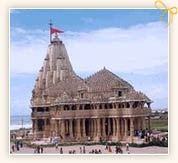
The Somnath temple is dedicated to Someshwara,
another name of Lord Shiva with moon on his head. The temple is
situated in Saurashtra. It is believed that Somraj, the Moon God
himself had originally built the temple out of gold. Somnath is the
first of all the 12 jyotirlingas. Though the temple is of Hindu
origin, the Architecture has Jain influences. The Somnath temple has
been destroyed six times and have been rebuilt. The temple faces the
east direction. Externally the Somnath temple resembles the
Rudramala temple at Siddhapur. The dome of the temple is the biggest
ever made in this century. The temple has large central hall with
entrances on three sides, each protected by a lofty porch. The
temple carvings and the sculptures speak about the great artistic
endeavor made by the craftsmen of that era. At a certain interval in
the balconied corridor is a deformed Nataraja statue.
Somnath is also known by different names like- Deo pattan, Prabhas
Pattan or Pattan Somnath. It is believed that 2000 priests served
the idol of the temple. The Somnath temple has a long history
attached to it. The first temple of Somnath is believed to have
existed before the christian era. The second temple was built by the
Maitraka Kings of Vallabhi in Gujarat. The Pratihara King- Nagabhata
II constructed the third temple. The fourth temple was built by the
Paramara King Bhoj of Malwa and the Solanki King. Kumarpal built the
fifth temple and was again destroyed by Mughal emperor Aurangazeb.
The present temple is the seventh temple and has been rebuilt and
taken care by Shree Somnath trust.
Sree Sailam-Mallikarjun Temple
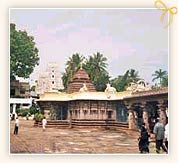
The Sree Sailam Temple located in Kurnool district,
is one of the 12 Jyotirlingam. Sri Sailam is a small city situated
in the densely forested Nallamalai hills. This temple is considered
very holy and is dedicated to Mallikarjuna Swamy and Bhramaramba.
One unique feature of the temple is that all the devotees who visit
the temple are allowed to touch the idol which is not prevalent in
any other temple. The temple is located at a distance of 245 km from
Hyderabad. The Sree Sailam temple has rich sculptural work, fort
like walls and towers. The temple is built in Dravidian style.
According to popular legends, the religious leader had visited the
temple and had composed his famous Sivananda Lahiri. It is also
believed that Goddess Durga had taken the form of a bee and
worshiped Lord Shiva here and selected this holy place as her abode.
There are some temples in the vicinity of Sree Sailam Temple, they
are-
- Tripurantakam to the east of Sree Sailam.
- Siddavatam of Cuddapah district to the South.
- Alampur Navabhrama temples in Mahboobnagar district to the
West.
- Umamaheswaram in Mahboobnagar district to the North.
- Paladhara Panchadara : The spot where Adi Sankara is
said to have meditated.
- Hatakeswaram : Another Shiva temple near Paladhara
Panchadara where the lingam was originally made of gold.
- Sakthi Ganapathi temple : It is considered important to
visit this temple before visiting Sri Sailam.
- Kailasa Dwaram : The main entrance to Sri Sailam for
those trekking to the temple.
- Sikharam : There is a hill temple dedicated to Shiva at
a height of 2850 feet above sea level in the Nallamalai hills
- Patalaganga : is where the bathing ghats associated
with Sri Sailam are located. (Krishna river).
Mahakaleshwar Jyotirlinga Temple
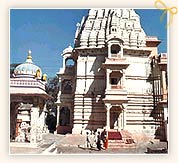
Mahakaleshwar Jyotirlinga Temple is situated in
Ujjain, the historical capital of Central India. This Temple is
situated near a lake. The idol in the temple is known as
Dakshinamurti, facing the south. The idols in the temple are all
strategically placed like the images of Ganesh, Parvati and
Karttikeya installed in the west, north and east direction
respectively. The image of Nandi is situated in the south direction.
The idol of Nagchandreshwar is situated in the third storey and
pilgrims are allowed to pay homage to the diety only on the day of
Nagapanchami. Among the 12 Jyotirlingas, the Mahakal Jyotirlinga is
believed to be swayambhu, meaning 'born of itself'. It is believed
that the holy powers of the Jyotirlinga are self derived from within
and unlike other Jyotirlinga, they are not ritually established
through Mantra Shakti.
The Mahakaleshwar temple is made in five levels, one of which is
underground. The Temple is surrounded by huge walls. The Temple peak
is decorated with fine sculptures. The underground sanctum is
lightened by brass lamps. The prasada in the temple can be
re-offered unlike other temples. According to the legends, a demon
called Dushana tormented the people of Avanti and then Lord Shiva
appeared from the ground and rescued the people and then on the
request of the people, Lord Shiva permanently settled there as
Mahakaleshwar Jyotirlinga. The glory of the Mahakaleshwar Temple has
been mentioned in the Tamil hymns of the Nayanmar saints of the 1st
millenium CE. The Parvati - Harasiddhi temple is also situated in
Ujjain. A huge fair is held on the day of Mahashivratri near the
Temple and the worshiping of Lord Shiva goes on through out the
night.
Nageshwar Jyotirlinga Temple
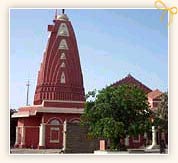
The Nageshwar Jyotirlinga Temple is one of the 12
Jyotirlinga Temples of Lord Shiva. The Jyotirlinga in the temple is
known as Nageshwar Mahadev. The temple is visited by thousands of
pilgrims every year. The Jyotirlinga situated in the temple is
considered to protect everybody from all sort of poisons. It is
believed that one who offers prayers in the temple becomes poison
free. The temple is located between Dwarka and Dwarka island in
Gujarat on the coast of Surat. According to the legends, a devotee
called Supriya was attacked by a demon named Daaruka in a boat.
The demon imprisoned the devotee and several others in his capital
called Daarukaavana. It is believed that Lord Shiva appeared in the
form of Jyotirlinga and rescued the imprisoned and vanquished the
demon. The Shivalingam in the temple faces South with the Gomugam
facing East. There is a legend regarding the position of the idol.
It is believed that a devotee called Naamdev was singing bhajans in
praise of Lord Shiva and was asked by other devotees to stand aside
and not to hide the image of Lord. On being asked to do so Naamdev
argued and asked for one such direction where Lord is not present,
this angered the devotees and they picked him up and placed him on
the south side. To everyones astonishment even the Linga was then
facing South with the Gomugam facing east. The other two temples
dedicated to Nageshwar Jyotirlinga are situated near Audhgram near
Purna and another near Almora in Uttar Pradesh.
Rameshwar Jyotirlinga Mandir
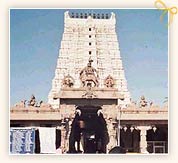
The Rameshwar Jyotirlinga is considered as the
southmost Jyotirlingams of India. The mandir is siyuated on an
island located on the south eastern coast of Tamil nadu. To the
right of the Lords shrine is the shrine for Parvathi. To its North
is the Kasi Viswanathars shrine. The temple has close association
with Lord Rama and his victorious return from Sri Lanka. It is
believed that the ancient shrine was a thatched hut till it was
rebuilt by Parakrama Bahu of Sri Lanka into a lofty temple in the
12th century. The rest of the temple was completed by the Sethupathy
rulers of Ramanathapuram. Between the 12th and the 16th century much
of the additions were carried out in the temple. The temple has six
worship services, the first one taking place at 5am in the morning.
A special worship service takes place every Friday. There are 36
Theertham meaning water springs in Rameshwaram out of which 22 are
situated in the temple.
The water of these springs are said to have medicinal properties.
There is another Shivalingam situated in the temple. It is believed
that this Lingam was brought by Hanuman from Benaras. This
Shivalingam is referred to as Kasilingam and Hanumalingam. The
Legend regarding the temple goes this way that Lord Rama wanted to
worship Lord Shiva and so had asked Hanuman to get an image of
Viswanathar from Benares. Hanuman got a bit delayed and so Lord Rama
offered his prayer to a Shivalingam made out of earth by Goddess
Sita on a pre-chosen auspicious moment. This Lingam came to be known
as Ramalingam and the town is known as Rameswaram. There is a nearby
hill in the island called Gandamadana parvatam and has a small
temple where imprints of Rama's feet are worshipped. This hill also
provides a majestic view of the temple.
There also exists a shrine dedicated to Ganapathi and Subramanya.
The Rameshwaram temple is spread over an area of 15 acres with lofty
towers, impressive 4000 feet long pillared corridor with over 4000
pillars. One unique feature about the corridor is that the rocks
used are not originally from the island but have been brought from
other places across the sea. The Rajagopuram on the eastern side
towers to a height of 126 feet and it has nine levels. The western
Gopuram is impressive but not as tall as the eastern one. There is a
huge Nandi measuring 12 feet in length and 9 feet in height. To the
North of the temple is the Kasi Viswanathars shrine. Two annual
festivals are celebrated between June 15 and July15. This festival
commemorates Lord Rama's worship.
Grishneshwar Jyotirlinga Temple
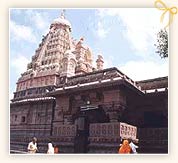
The Grishneshwar Jyotirlinga Temple is one of the
ancient and holiest shrines of India. This temple is the holy abode
of one of the 12 jyotirlinga of Lord Shiva. The temple is located at
a distance of 11km from Daulatabad near Aurangabad in Maharashtra.
Daulatabad was once known as Devagiri. Ahilyabhai Holkar constructed
the Grishneshwar Temple, who also re-constructed the Kasi Viswanatha
temple at Banaras and the Vishnu Paada temple at Gaya. Grishneshwar
is also known as Ghushmeswara. The Lord is also known by several
names like Kusumeswarar, Ghushmeswara, etc.
The famous Ajanta and Elora caves are the famous tourist spots
nearby the temple. According to legend, a devotee called Kusuma
worshiped Lord Shiva by immersing a Shivalingam everyday in a nearby
tank. Kusuma's husband's first wife out of jealousy because of
Kusuma's piety in the society killed her son. An aggrieved Kusuma
continued her daily ritual and when she dipped the Shivlingam in the
tank her son miraculously revived. From then on the people started
worshiping Lord Shiva in the form of a Jyotirlinga Ghusmeshwar.
Tryambakeshwar Jyotirlinga Temple
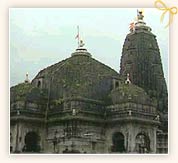
Tryambakeshwar is one of the 12 Jyotirlinga shrines
situated 30 km from Nasik in Maharashtra. Considered to be the birth
place of the river Godavari, the shrine's beauty is still well
intact. The effort made by the Peshwa Balaji Bajirao in mid 18th
century has kept the magic of the shrine's architecture still alive.
The influence of the Nagara style of architecture can be well seen
through the extensive usage of black stone. A small Shivalingam or
Tryambaka, is placed amidst a spacious courtyard & the sanctum which
is crowned with a graceful tower, a giant amalaka and a golden
kalasha. A mandap with doors on all sides enhances the beauty well
situated in front of the garbagriha and the antaral. Three doorways
are covered with porches whose opening are ornamented with pillars
and arches. The mandapam's roof has curvilinear slabs rising in
steps. Sculptural work can be traced everywhere featuring running
scrolls, floral designs, figures of gods, yakshas, humans and
animals.
The Shivalingam is situated in a depression on the floor of the
sanctum. Continuous flow of water from the top of the Shivalingam
adds to the mystic beauty. Shivalingam is generally covered with a
silver mask which is then substituted with a golden mask with five
faces on festive occasion. These faces have their respective golden
crowns. While, the silver mask is similar to the processional images
seen in South Indian temples.
The worship service is carried out thrice on daily basis. Night is
meant for the sheja-aarti service where in a mirrored hall, the
silver mask is placed on a bed. According to the ritual, on every
monday, the silver mask of Tryambaka is placed in a palanquin. This
is taken in a procession to Kushavarta theertha where its given an
abhisheka. While days like Shiv ratris, full moon day in the month
of Kartika & other festive occasions are meant for the special
golden mask procession.
As far as the legend goes, Gowtama muni resided on the Bhramagiri
hill. Once he worshiped Lord Shiva to bring the Ganga down to purify
his premises, as he had committed a sin of killing a cow while in
his quest to protect his granary. Therefore, the Ganga came down as
Godavari while Shiva came in the form of Tryambaka. The other legend
relating to the Lingodbhava manifestation of Shiva also prevails
here. Tryambakeshwar has been referred to in the Padma Purana.
Bhimashankar Jyotirlinga Temple
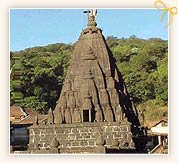
Bhimashankar, the origin of Bhima river, is located
on a high peak, surrounded by thick dense forests. It is one of the
major pilgrim center which is the abode for one of the five
'Jyotirlinga' of Maharashtra. Innumerable devotees flock near the
temple during 'Tripuri Poornima'. The breathtaking scenic beauty &
the picture perfect setting of Bhimashankar has made it a hit
tourist center, especially famous for trekking, sight seeing &
mountaineering.
Bhimashankar temple houses the main 'Shani temple'. One of the two
main pillars outside the 'Shani' temple is actually an ancient huge
Portuguese bell. The impact of Nagara style can be well make out.
Dating back to mid 18th century, the shikhara was built by Nana
Phadnavis. The sanctum is located at the lower level. The shrine
Bhimashankaram, though dates back to the 13th century. Bhimashankar
temple is well surrounded with Kamalaja shrine & Mokshakund thirtha.
As per the ritual, at least three worship services are offered on a
daily basis. Mahashivratri is the most auspicious day here.
Lord Shiva's killing of the demon Tripurasura is the main legend
associated with the temple. It even states that Shiva took abode on
the Sahyadri hills in the form of a Bhima upon the request of the
Gods, on the crest of the Sahyadri hills. The sweat of Shiva poured
after the battle ultimately led to the origin of Bhimarathi river.
Kedarnath

Kedarnath is a Hindu holy town located in the the
Indian state of Uttaranchal. The place is located at an altitude of
3,584 m and at the origin of the river Mandakini, the temple of
Kedarnath is the most venerated place for Hindu pilgrims. Amidst the
dramatic mountain scapes of the majestic Kedarnath range stands one
of the twelve 'Jyotirlingas' of Kedar or Lord Shiva. Kedarnath hosts
one of the holiest Hindu temples and is a popular destination for
Hindu pilgrims from all over the world. The place is accessible
after a steep 13 km trek over a paved path from Gaurikund.
Rishikesh, Haridwar, Dehradun are well connected to Gaurikund by
road. There are different places on the route like- Rambara,
Janglechatti and Garurchatti, where one can spend some time while
trekking or can even spend a night as a halting station. There is a
high and beautiful cascading waterfall just one kilometer before
Rambara. The main attraction at Kedarnath is the Kedarnath
Jyotirlinga Temple, which is one of the Panch Kendras located in the
Himalayas, at the source of the Mandakani river. It is about 120000
feet above the sea level. One can get a glimpse of the God when
traveling by foot. The picture perfect setting with breathtaking
scenic beauty transforms it in a heaven. Perpetually covered with
snow, the place is best accessible from May to October except the
Monsoon.
The credit for the construction of this heavenly temple is given to
the Pandavas. The entrance starts with the statue of Nandi, the
divine bull of Shiva. Fine & detailed carvings exhibiting images can
be seen on the walls inside. The shiva lingam is in the form of a
pyramid. The Kedar dome peak is located exactly behind the temple.
It can be viewed from great distance as well. The temple is located
on the Rudra Himalaya range, also known as the Pancha Parvata. It is
believed that four of the Pandavas died on one of the peaks,
Swargarohini.
The holy statue of Shiva is carried from Garhwal (Kedarkhand) to
Ukhnimath in November which is then restablished at Kedarnath in the
first week of May. The doors of the temple are now thrown open to
pilgrims.
Mythology states that the deity of Kedarnath temple is identified
with the rump of a bull. Shiva had camouflaged himself while eluding
the Pandavas, who had come to repent for killing their kith and kin,
during the battle of Kurukshetra. Shiva dived into the ground, thus,
leaving a hump on the surface. This very conical projection is
worshipped till now.
The temple is open only during the months of May to October, due to
heavy snowfall and extreme cold weather during winter. The origin of
this revered temple is mentioned in the great epic-Mahabharata.
According to the saying it is believed that the Pandavas came to
Lord Shiva to seek blessings to atone their sins after the battle of
Mahabharata. Lord Shiva evaded them continuously and took refuge in
Kedarnath in the form of a Bull. On being chased, Lord Shiva left
his hump behind. This conical protusion is worshiped in the temple.
During the winters, the shrine is submerged in snow and hence is
closed. The ideal time to visit is between May to October. The
remaining portions of Lord Shiva are worshiped at four other places
like-
- The arms {baahu} - at Tungnath
- The mouth {mukh} - at Rudranath
- The hair {jata} - at Kapleshwar
Things to remember
- The best season to visit is May to October except monsoon
- One may carry light woolens in summer and must carry heavy
woolens in winter
- The colloquial Language in use are Hindi, Garhwali and English
- The nearest airport is Jolly Grant, Dehradun (251 kms.)
- The nearest railway stations are Rishikesh (234 kms.) Kotdwar
(260 kms.)
- The walking route starts from Gaurikund which is connected by
road to Rishikesh, Kotdwar, Dehradun, Haridwar and other important
hill stations of Garhwal and Kumaon region
- There are halting stations like Dharamshalas, Ashrams,
Cottages and Tourist Rest House for comfortable stay
There are some important fairs that are organized at Kedarnath
anually like :
- Nagnath (Feb.)
- Sardotsava, Joshimath (Feb.)
- Sardotsava Chamoli, Gopeshwar (Feb. - Mar.)
- Shivaratri, Gopeshwar (Feb. - Mar.)
- Nanda Devi, Nauti (Mar.)
- Maithan, Maithan (Mar.)
- Bishwat Sankranti, Karnaprayag
- Nandprayag (April)
- Bikhot, Agastyamuni (April)
- Nautha, Adi Badri (May)
- Kaviltha, Kaviltha (Jun.)
- Naumi, Jasoli Haryali (Aug.)
- Bhaikhal, Mela, Bhaikhaltal (Aug.)
Omkareshwar Jyotirlinga Temple
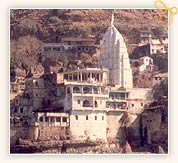
Omkareshwar, an island on the banks of the Narmada,
is located on the Mandhata hill in Madhya Pradesh. The Omkareshwar
Jyotirlinga shrine and the Amareshwar temple is one of the 12
revered Jyotirlinga shrines of Shiva. The river Narmada branches
into two which forms an island Mandhata or Shivapuri in the center.
Ironically, the island's shape resembles the visual representation
of the Omkara sound, Om. The temple can be reached by ferry.
The influence of the Nagara architecture can be well made out. The
proof is the lofty shikhara. High spires are another eye catching
point of the temple. Shrines dedicated to Annapurna & Ganesha are
also found here. Worshiping Panchamuga Ganesha is considered to be
very auspicious.
One has to go through two rooms before entering the temple. With
mysterious circumstances, the Omkareshwar is naturally installed
there surrounded by water. The highlight of this particular linga is
its location which is not below the cupola. Lord Shiva's idol is
situated on the top of the temple. Kartik Poornima is supposed to be
the organization of a huge fair.
As per the legend, Vindhya mountain once prayed to Lord Shiva or
Omkareshwara and got blessed in return. Other story says that the
Shivalinga was split into two upon the request of the Devas. Thus,
the formation of Omkareshwara and Amareshwar.
Vaidyanatha Jyotirlinga Temple
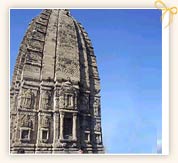
Vaidhyanath is located at Deogarh in the Santal
Parganas area of Bihar. Deogarh is also known as Vaidyanath.
The temple is situated in a spacious courtyard surrounded by stone
walls. Within the vicinity of the temple complex, twenty two other
temples are as well found. The temple faces the east. The top of the
Shiva Lingam is slightly broken which as per the legend happened
when Ravana tried to uproot it. Sivaganga lake is positioned just
near the temple. While the Chandrakoopa well found near the main
entrance is said to have been filled with water by Ravana from
several thirthams. The Shiva's temple is almost 72 feet tall in the
form of a lotus. There are three ascending shaped gold vessels on
the top. Then there is a 'Punchsula' as well as an eight petaled
lotus jewel called 'Chandrakanta Mani'.
According to mythology, Ravana meditated hard to invoke Lord Shiva.
In his desire to become invinciible, he attempted to lift Lord
Shiva's abode, Mount Kailash. The act offended the Lord. He punished
him but with Ravana pleading for mercy, he left him on one
condition. He gave him one of the twelve lingas which was not
supposed to be kept on ground in any case. But Ravana's promise gave
way infront of nature's call & kept the linga on the ground. In
order to rectify the mistake, Ravana started cutting off nine of his
heads as a part of his repentance. Shiva was pleased by this & he
joined the heads again to the body.
Worshipping Vaidhyanath Jyotirlinga is considered to eliminate one's
all worries and miseries. It even imparts Moksha. In order to
complete the travel, devotees carry Kanwars on their shoulders.
Vishwanath Jyotirlinga Temple
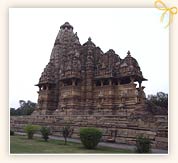
The Vishwanath temple in Benares, Uttar Pradesh
is a hot spot for thousands of pilgrims. Vishwanatha got its name
from two rivers, Varana and Asi. It is the abode of Shiva.
This temple has its own saga to tell. It was desecrated and
rebuilt countless times. Rani Ahilyabhai Holkar in the 18th
century is reponsible for the latest structure. Pilgrims come here
to perform abhishekam to the pious Jotirlingam with holy Ganges
water.
The temple can be approached from a lane called Vishwanatha lane.
The temple is surrounded by many subsidiary shrines. A well called
Jnana Vapi is also located to the north of the main temple. There
are three temples in a row as one enters from the southern side of
the first temple. There are many temples with their own set of
llingas. So much so that often the confusion arises as to which
enshrines the original Jyotirlinga.
The temple boasts of a mandapa and a sanctum. A linga made of
black stone is well placed in the center of the floor in a square
silver altar inside the sanctum. The interior is not very
extensive.
Pilgrims can pay homage to the Lord at any time of the day.
Ritually, the Shringaar Aarti is performed five times a day where
the linga is well decorated with flowers. Shivaratri in February
is considered to be the festive day.
As per the legend, the earring of Shiva fell into the pit that
Vishnu had dug. It, thus, got its name Manikarnika which is
considered holy for cremation.
Both of them include a set of highly esteemed Hindu religious
temples where every year large number of pilgrims pay a holy visit
to satisfy their quench for spiritualism.
 The Hindu religious temple is a house of worship for
the followers of Hinduism. They are usually dedicated to any one prime
deity or multiple of them. They inherited rich & ancient rituals &
customs which have been kept intact till date. Since ages, the
architectural part has been given prime importance keeping in mind the
religious and spiritual activities to be followed at these sacred
places. Today, they not only serve as pilgrim centers but also has hot
tourist destinations simply because of their intricate architectural
designs & patterns. The legends related to them make them all the more
happening in every way.
The Hindu religious temple is a house of worship for
the followers of Hinduism. They are usually dedicated to any one prime
deity or multiple of them. They inherited rich & ancient rituals &
customs which have been kept intact till date. Since ages, the
architectural part has been given prime importance keeping in mind the
religious and spiritual activities to be followed at these sacred
places. Today, they not only serve as pilgrim centers but also has hot
tourist destinations simply because of their intricate architectural
designs & patterns. The legends related to them make them all the more
happening in every way. The Char Dham is considered a vital Hindu
pilgrimage circuit in the Indian Himalayas. The picture perfect
location in the Garhwal section of the state of Uttarakhand,
consists of four sites - Yamunotri, Gangotri, Kedarnath and
Badrinath. All the site in the circuit has the backing of an
autonomous history. They are seen as hot destinations because of
their beautiful locales as well as pilgrim centers. The Char Dham
has always been seen as a source to come in contact with the divine
power. The mystical journey has been mentioned as 'Kedarkhand' in
ancient Hindu scriptures.
The Char Dham is considered a vital Hindu
pilgrimage circuit in the Indian Himalayas. The picture perfect
location in the Garhwal section of the state of Uttarakhand,
consists of four sites - Yamunotri, Gangotri, Kedarnath and
Badrinath. All the site in the circuit has the backing of an
autonomous history. They are seen as hot destinations because of
their beautiful locales as well as pilgrim centers. The Char Dham
has always been seen as a source to come in contact with the divine
power. The mystical journey has been mentioned as 'Kedarkhand' in
ancient Hindu scriptures.
 Badrinath is a Hindu holy town in Uttaranchal, India
and considered to be the most important of the four sites in India's
Chardham pilgrimage. It is an important destination on the sacred
itinerary of every devout Hindu. It has been emphasized in the ancient
scriptures that there are many sacred spots of pilgrimage in the
Earth, Heaven and the Nether world, but there has been none equal to
Badri nor there shall be. The significance of this place is that it is
considered to be the seat of the God Vishnu in his aspect of
Badrinarayana. The prime sites in this area are Badrinath Temple, Tapt
Kund, Brahma Kapal, Charanpaduka, Sheshnetra, Neelkantha. Another
important religious attraction at Badrinath is the Badrinath Temple
which is considered as the abode of Lord Vishnu and is situated at
3,124 meters above sea level in the Himalayas. The temple has three
parts - Garbha Grih (The Sanctum Sanctorum), Darshan Mandap (for pujas)
and Sabha Mandap (for devotees to assemble). At the backdrop is the
Neelkanth mountain peak situated between twin peaks named Nar and
Narayan. The Badrinath temple was built by the Gharwal kings.
Badrinath is a Hindu holy town in Uttaranchal, India
and considered to be the most important of the four sites in India's
Chardham pilgrimage. It is an important destination on the sacred
itinerary of every devout Hindu. It has been emphasized in the ancient
scriptures that there are many sacred spots of pilgrimage in the
Earth, Heaven and the Nether world, but there has been none equal to
Badri nor there shall be. The significance of this place is that it is
considered to be the seat of the God Vishnu in his aspect of
Badrinarayana. The prime sites in this area are Badrinath Temple, Tapt
Kund, Brahma Kapal, Charanpaduka, Sheshnetra, Neelkantha. Another
important religious attraction at Badrinath is the Badrinath Temple
which is considered as the abode of Lord Vishnu and is situated at
3,124 meters above sea level in the Himalayas. The temple has three
parts - Garbha Grih (The Sanctum Sanctorum), Darshan Mandap (for pujas)
and Sabha Mandap (for devotees to assemble). At the backdrop is the
Neelkanth mountain peak situated between twin peaks named Nar and
Narayan. The Badrinath temple was built by the Gharwal kings. Gangotri, is known as the source of river Ganges
and is believed that Goddess Ganga resides here. Gangotri is one of
the four sites of Char Dhaam. The physical source of the river is at
Gaumukh, this place is 18 km ahead. Pilgrims do trek this path to
offer prayer to the Goddess at this holy spot. At the source the
river is called Bhagirathi and from Devprayag it is called Ganga
here it meets river Alaknanda. The origin of the holy river Ganges
is at Gaumukh. The place is approachable after 18 km trek along the
Gangotri glacier. According to popular legends, Goddess Ganga took
the form of a river in order to wash off the sins committed by the
King Bhagirath's predecessors. There is a submerged Shivling in the
river. It is believed that Lord Shiva sat here and tamed the gushing
flow of river Ganges in his matted locks.
Gangotri, is known as the source of river Ganges
and is believed that Goddess Ganga resides here. Gangotri is one of
the four sites of Char Dhaam. The physical source of the river is at
Gaumukh, this place is 18 km ahead. Pilgrims do trek this path to
offer prayer to the Goddess at this holy spot. At the source the
river is called Bhagirathi and from Devprayag it is called Ganga
here it meets river Alaknanda. The origin of the holy river Ganges
is at Gaumukh. The place is approachable after 18 km trek along the
Gangotri glacier. According to popular legends, Goddess Ganga took
the form of a river in order to wash off the sins committed by the
King Bhagirath's predecessors. There is a submerged Shivling in the
river. It is believed that Lord Shiva sat here and tamed the gushing
flow of river Ganges in his matted locks. Kedarnath is a Hindu holy town located in the the
Indian state of Uttaranchal. The place is located at an altitude of
3,584 m and at the origin of the river Mandakini, the temple of
Kedarnath is the most venerated place for Hindu pilgrims. Amidst the
dramatic mountain scapes of the majestic Kedarnath range stands one
of the twelve 'Jyotirlingas' of Kedar or Lord Shiva. Kedarnath hosts
one of the holiest Hindu temples and is a popular destination for
Hindu pilgrims from all over the world. The place is accessible
after a steep 13 km trek over a paved path from Gaurikund. Rishikesh,
Haridwar, Dehradun are well connected to Gaurikund by road. There
are different places on the route like- Rambara, Janglechatti and
Garurchatti, where one can spend some time while trekking or can
even spend a night as a halting station. There is a high and
beautiful cascading waterfall just one kilometer before Rambara. The
main attraction at Kedarnath is the Kedarnath Jyotirlinga Temple,
which is one of the Panch Kendras located in the Himalayas, at the
source of the Mandakani river. It is about 120000 feet above the sea
level. One can get a glimpse of the God when traveling by foot. The
picture perfect setting with breathtaking scenic beauty transforms
it in a heaven. Perpetually covered with snow, the place is best
accessible from May to October except the Monsoon.
Kedarnath is a Hindu holy town located in the the
Indian state of Uttaranchal. The place is located at an altitude of
3,584 m and at the origin of the river Mandakini, the temple of
Kedarnath is the most venerated place for Hindu pilgrims. Amidst the
dramatic mountain scapes of the majestic Kedarnath range stands one
of the twelve 'Jyotirlingas' of Kedar or Lord Shiva. Kedarnath hosts
one of the holiest Hindu temples and is a popular destination for
Hindu pilgrims from all over the world. The place is accessible
after a steep 13 km trek over a paved path from Gaurikund. Rishikesh,
Haridwar, Dehradun are well connected to Gaurikund by road. There
are different places on the route like- Rambara, Janglechatti and
Garurchatti, where one can spend some time while trekking or can
even spend a night as a halting station. There is a high and
beautiful cascading waterfall just one kilometer before Rambara. The
main attraction at Kedarnath is the Kedarnath Jyotirlinga Temple,
which is one of the Panch Kendras located in the Himalayas, at the
source of the Mandakani river. It is about 120000 feet above the sea
level. One can get a glimpse of the God when traveling by foot. The
picture perfect setting with breathtaking scenic beauty transforms
it in a heaven. Perpetually covered with snow, the place is best
accessible from May to October except the Monsoon. The shrine of Yamunotri is situated in the opposite
direction of Gangotri. Yamunotri is the source of river yamuna which
originates from the Champasar Glacier. This spot is not generally
visited by pilgrims as it is not easy to approach the place. The
shrine is placed at an elevation of 3235 meters. Dharasu is the
strategic point from where the road bifurcates to Yamunotri and
Gangotri, this place is between Rishikesh- Uttarkashi. The holy
shrine of Yamunotri is one of the four Dhams of Uttarakhand. At an
altitude of 4421 meters is situated the source of Yamuna, this is 1
km ahead of the shrine. Reaching the source is very difficult hence
the pilgrims offer their prayers in the shrine itself. The pilgrims
take a refreshing bath in the hot water springs situated nearby the
temple.
The shrine of Yamunotri is situated in the opposite
direction of Gangotri. Yamunotri is the source of river yamuna which
originates from the Champasar Glacier. This spot is not generally
visited by pilgrims as it is not easy to approach the place. The
shrine is placed at an elevation of 3235 meters. Dharasu is the
strategic point from where the road bifurcates to Yamunotri and
Gangotri, this place is between Rishikesh- Uttarkashi. The holy
shrine of Yamunotri is one of the four Dhams of Uttarakhand. At an
altitude of 4421 meters is situated the source of Yamuna, this is 1
km ahead of the shrine. Reaching the source is very difficult hence
the pilgrims offer their prayers in the shrine itself. The pilgrims
take a refreshing bath in the hot water springs situated nearby the
temple. The 12 jyotirlinga shrines, popularly known as the
Dwadasa Jyotirlinga shrines are considered to be very holy by the
Hindus. The Jyotirlingas have held an important position in the
Indian belief system. The Jyotirlinga temples have a rich tradition
and each temple has a legend attached to it. They are situated in
different parts of India. The northernmost Jyotirlinga is located in
the snow clad Himalayas at Kedarnath. The southernmost Jyotirlinga
is situated at Rameswaram. These temples provide a fine view of
Indian architecture and definitely add to the rich glory and
tradition of Indian history. These places are a must visit both in
terms of pilgrimage and as tourist destinations.
The 12 jyotirlinga shrines, popularly known as the
Dwadasa Jyotirlinga shrines are considered to be very holy by the
Hindus. The Jyotirlingas have held an important position in the
Indian belief system. The Jyotirlinga temples have a rich tradition
and each temple has a legend attached to it. They are situated in
different parts of India. The northernmost Jyotirlinga is located in
the snow clad Himalayas at Kedarnath. The southernmost Jyotirlinga
is situated at Rameswaram. These temples provide a fine view of
Indian architecture and definitely add to the rich glory and
tradition of Indian history. These places are a must visit both in
terms of pilgrimage and as tourist destinations. The Somnath temple is dedicated to Someshwara,
another name of Lord Shiva with moon on his head. The temple is
situated in Saurashtra. It is believed that Somraj, the Moon God
himself had originally built the temple out of gold. Somnath is the
first of all the 12 jyotirlingas. Though the temple is of Hindu
origin, the Architecture has Jain influences. The Somnath temple has
been destroyed six times and have been rebuilt. The temple faces the
east direction. Externally the Somnath temple resembles the
Rudramala temple at Siddhapur. The dome of the temple is the biggest
ever made in this century. The temple has large central hall with
entrances on three sides, each protected by a lofty porch. The
temple carvings and the sculptures speak about the great artistic
endeavor made by the craftsmen of that era. At a certain interval in
the balconied corridor is a deformed Nataraja statue.
The Somnath temple is dedicated to Someshwara,
another name of Lord Shiva with moon on his head. The temple is
situated in Saurashtra. It is believed that Somraj, the Moon God
himself had originally built the temple out of gold. Somnath is the
first of all the 12 jyotirlingas. Though the temple is of Hindu
origin, the Architecture has Jain influences. The Somnath temple has
been destroyed six times and have been rebuilt. The temple faces the
east direction. Externally the Somnath temple resembles the
Rudramala temple at Siddhapur. The dome of the temple is the biggest
ever made in this century. The temple has large central hall with
entrances on three sides, each protected by a lofty porch. The
temple carvings and the sculptures speak about the great artistic
endeavor made by the craftsmen of that era. At a certain interval in
the balconied corridor is a deformed Nataraja statue. The Sree Sailam Temple located in Kurnool district,
is one of the 12 Jyotirlingam. Sri Sailam is a small city situated
in the densely forested Nallamalai hills. This temple is considered
very holy and is dedicated to Mallikarjuna Swamy and Bhramaramba.
One unique feature of the temple is that all the devotees who visit
the temple are allowed to touch the idol which is not prevalent in
any other temple. The temple is located at a distance of 245 km from
Hyderabad. The Sree Sailam temple has rich sculptural work, fort
like walls and towers. The temple is built in Dravidian style.
According to popular legends, the religious leader had visited the
temple and had composed his famous Sivananda Lahiri. It is also
believed that Goddess Durga had taken the form of a bee and
worshiped Lord Shiva here and selected this holy place as her abode.
There are some temples in the vicinity of Sree Sailam Temple, they
are-
The Sree Sailam Temple located in Kurnool district,
is one of the 12 Jyotirlingam. Sri Sailam is a small city situated
in the densely forested Nallamalai hills. This temple is considered
very holy and is dedicated to Mallikarjuna Swamy and Bhramaramba.
One unique feature of the temple is that all the devotees who visit
the temple are allowed to touch the idol which is not prevalent in
any other temple. The temple is located at a distance of 245 km from
Hyderabad. The Sree Sailam temple has rich sculptural work, fort
like walls and towers. The temple is built in Dravidian style.
According to popular legends, the religious leader had visited the
temple and had composed his famous Sivananda Lahiri. It is also
believed that Goddess Durga had taken the form of a bee and
worshiped Lord Shiva here and selected this holy place as her abode.
There are some temples in the vicinity of Sree Sailam Temple, they
are-
 Mahakaleshwar Jyotirlinga Temple is situated in
Ujjain, the historical capital of Central India. This Temple is
situated near a lake. The idol in the temple is known as
Dakshinamurti, facing the south. The idols in the temple are all
strategically placed like the images of Ganesh, Parvati and
Karttikeya installed in the west, north and east direction
respectively. The image of Nandi is situated in the south direction.
The idol of Nagchandreshwar is situated in the third storey and
pilgrims are allowed to pay homage to the diety only on the day of
Nagapanchami. Among the 12 Jyotirlingas, the Mahakal Jyotirlinga is
believed to be swayambhu, meaning 'born of itself'. It is believed
that the holy powers of the Jyotirlinga are self derived from within
and unlike other Jyotirlinga, they are not ritually established
through Mantra Shakti.
Mahakaleshwar Jyotirlinga Temple is situated in
Ujjain, the historical capital of Central India. This Temple is
situated near a lake. The idol in the temple is known as
Dakshinamurti, facing the south. The idols in the temple are all
strategically placed like the images of Ganesh, Parvati and
Karttikeya installed in the west, north and east direction
respectively. The image of Nandi is situated in the south direction.
The idol of Nagchandreshwar is situated in the third storey and
pilgrims are allowed to pay homage to the diety only on the day of
Nagapanchami. Among the 12 Jyotirlingas, the Mahakal Jyotirlinga is
believed to be swayambhu, meaning 'born of itself'. It is believed
that the holy powers of the Jyotirlinga are self derived from within
and unlike other Jyotirlinga, they are not ritually established
through Mantra Shakti. The Nageshwar Jyotirlinga Temple is one of the 12
Jyotirlinga Temples of Lord Shiva. The Jyotirlinga in the temple is
known as Nageshwar Mahadev. The temple is visited by thousands of
pilgrims every year. The Jyotirlinga situated in the temple is
considered to protect everybody from all sort of poisons. It is
believed that one who offers prayers in the temple becomes poison
free. The temple is located between Dwarka and Dwarka island in
Gujarat on the coast of Surat. According to the legends, a devotee
called Supriya was attacked by a demon named Daaruka in a boat.
The Nageshwar Jyotirlinga Temple is one of the 12
Jyotirlinga Temples of Lord Shiva. The Jyotirlinga in the temple is
known as Nageshwar Mahadev. The temple is visited by thousands of
pilgrims every year. The Jyotirlinga situated in the temple is
considered to protect everybody from all sort of poisons. It is
believed that one who offers prayers in the temple becomes poison
free. The temple is located between Dwarka and Dwarka island in
Gujarat on the coast of Surat. According to the legends, a devotee
called Supriya was attacked by a demon named Daaruka in a boat. The Rameshwar Jyotirlinga is considered as the
southmost Jyotirlingams of India. The mandir is siyuated on an
island located on the south eastern coast of Tamil nadu. To the
right of the Lords shrine is the shrine for Parvathi. To its North
is the Kasi Viswanathars shrine. The temple has close association
with Lord Rama and his victorious return from Sri Lanka. It is
believed that the ancient shrine was a thatched hut till it was
rebuilt by Parakrama Bahu of Sri Lanka into a lofty temple in the
12th century. The rest of the temple was completed by the Sethupathy
rulers of Ramanathapuram. Between the 12th and the 16th century much
of the additions were carried out in the temple. The temple has six
worship services, the first one taking place at 5am in the morning.
A special worship service takes place every Friday. There are 36
Theertham meaning water springs in Rameshwaram out of which 22 are
situated in the temple.
The Rameshwar Jyotirlinga is considered as the
southmost Jyotirlingams of India. The mandir is siyuated on an
island located on the south eastern coast of Tamil nadu. To the
right of the Lords shrine is the shrine for Parvathi. To its North
is the Kasi Viswanathars shrine. The temple has close association
with Lord Rama and his victorious return from Sri Lanka. It is
believed that the ancient shrine was a thatched hut till it was
rebuilt by Parakrama Bahu of Sri Lanka into a lofty temple in the
12th century. The rest of the temple was completed by the Sethupathy
rulers of Ramanathapuram. Between the 12th and the 16th century much
of the additions were carried out in the temple. The temple has six
worship services, the first one taking place at 5am in the morning.
A special worship service takes place every Friday. There are 36
Theertham meaning water springs in Rameshwaram out of which 22 are
situated in the temple. The Grishneshwar Jyotirlinga Temple is one of the
ancient and holiest shrines of India. This temple is the holy abode
of one of the 12 jyotirlinga of Lord Shiva. The temple is located at
a distance of 11km from Daulatabad near Aurangabad in Maharashtra.
Daulatabad was once known as Devagiri. Ahilyabhai Holkar constructed
the Grishneshwar Temple, who also re-constructed the Kasi Viswanatha
temple at Banaras and the Vishnu Paada temple at Gaya. Grishneshwar
is also known as Ghushmeswara. The Lord is also known by several
names like Kusumeswarar, Ghushmeswara, etc.
The Grishneshwar Jyotirlinga Temple is one of the
ancient and holiest shrines of India. This temple is the holy abode
of one of the 12 jyotirlinga of Lord Shiva. The temple is located at
a distance of 11km from Daulatabad near Aurangabad in Maharashtra.
Daulatabad was once known as Devagiri. Ahilyabhai Holkar constructed
the Grishneshwar Temple, who also re-constructed the Kasi Viswanatha
temple at Banaras and the Vishnu Paada temple at Gaya. Grishneshwar
is also known as Ghushmeswara. The Lord is also known by several
names like Kusumeswarar, Ghushmeswara, etc. Tryambakeshwar is one of the 12 Jyotirlinga shrines
situated 30 km from Nasik in Maharashtra. Considered to be the birth
place of the river Godavari, the shrine's beauty is still well
intact. The effort made by the Peshwa Balaji Bajirao in mid 18th
century has kept the magic of the shrine's architecture still alive.
Tryambakeshwar is one of the 12 Jyotirlinga shrines
situated 30 km from Nasik in Maharashtra. Considered to be the birth
place of the river Godavari, the shrine's beauty is still well
intact. The effort made by the Peshwa Balaji Bajirao in mid 18th
century has kept the magic of the shrine's architecture still alive. Bhimashankar, the origin of Bhima river, is located
on a high peak, surrounded by thick dense forests. It is one of the
major pilgrim center which is the abode for one of the five
'Jyotirlinga' of Maharashtra. Innumerable devotees flock near the
temple during 'Tripuri Poornima'. The breathtaking scenic beauty &
the picture perfect setting of Bhimashankar has made it a hit
tourist center, especially famous for trekking, sight seeing &
mountaineering.
Bhimashankar, the origin of Bhima river, is located
on a high peak, surrounded by thick dense forests. It is one of the
major pilgrim center which is the abode for one of the five
'Jyotirlinga' of Maharashtra. Innumerable devotees flock near the
temple during 'Tripuri Poornima'. The breathtaking scenic beauty &
the picture perfect setting of Bhimashankar has made it a hit
tourist center, especially famous for trekking, sight seeing &
mountaineering. Omkareshwar, an island on the banks of the Narmada,
is located on the Mandhata hill in Madhya Pradesh. The Omkareshwar
Jyotirlinga shrine and the Amareshwar temple is one of the 12
revered Jyotirlinga shrines of Shiva. The river Narmada branches
into two which forms an island Mandhata or Shivapuri in the center.
Ironically, the island's shape resembles the visual representation
of the Omkara sound, Om. The temple can be reached by ferry.
Omkareshwar, an island on the banks of the Narmada,
is located on the Mandhata hill in Madhya Pradesh. The Omkareshwar
Jyotirlinga shrine and the Amareshwar temple is one of the 12
revered Jyotirlinga shrines of Shiva. The river Narmada branches
into two which forms an island Mandhata or Shivapuri in the center.
Ironically, the island's shape resembles the visual representation
of the Omkara sound, Om. The temple can be reached by ferry. Vaidhyanath is located at Deogarh in the Santal
Parganas area of Bihar. Deogarh is also known as Vaidyanath.
Vaidhyanath is located at Deogarh in the Santal
Parganas area of Bihar. Deogarh is also known as Vaidyanath. The Vishwanath temple in Benares, Uttar Pradesh
is a hot spot for thousands of pilgrims. Vishwanatha got its name
from two rivers, Varana and Asi. It is the abode of Shiva.
The Vishwanath temple in Benares, Uttar Pradesh
is a hot spot for thousands of pilgrims. Vishwanatha got its name
from two rivers, Varana and Asi. It is the abode of Shiva.